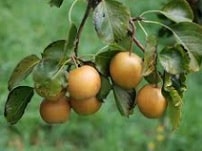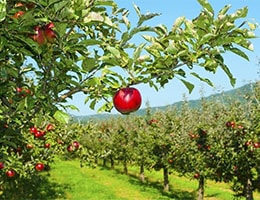 The cultivation of fruit trees is called fruit growing . The concept refers to the knowledge, techniques and procedures that allow this activity to be carried out successfully to obtain fruits .
The cultivation of fruit trees is called fruit growing . The concept refers to the knowledge, techniques and procedures that allow this activity to be carried out successfully to obtain fruits .
It should be remembered that fruits (such as apples, grapes, pears , oranges and plums) are the fruits of trees that are edible for humans. A fruit, in turn, is a product of certain plants that contains and provides protection to the seeds.
Fruit growing is usually developed with the objective of achieving the economic exploitation of fruit trees . The fruits obtained are harvested and marketed, allowing the producer to earn money .
For the development of fruit growing, experts seek to improve the genetics of the trees and optimize production techniques. This activity requires planning to make the most of the possibilities of each tree .
Fruit growing starts from soil analysis. Depending on their characteristics, added to other factors such as climate conditions and available economic resources, it is decided which plant species will be grown. Through genetic manipulation, later, attempts are made to improve the varieties.
Once the fruit trees reach the productive phase, you can opt for manual or mechanical harvesting. Fruit growing also deals with the stages after harvesting : the conditioning, packaging, conservation and eventual processing of the fruit until its marketing.
It is important to note that the fruit is not only consumed fresh (raw): it can also be used to make various products, such as oils and juices .
Life in the city gives us access to all types of plant products throughout the year, something that is not natural since not all fruits and vegetables grow in any season . Of course, this "convenience" of enjoying summer fruits in winter and vice versa leads to an obvious increase in prices. Those who are dedicated to fruit growing want to take advantage of the soil from January to December, and this is only possible by planting more than one variety so that each one can develop in its corresponding season.
 In addition to this trick to avoid wasting the soil in certain seasons of the year, it is recommended to combine cultivars with different degrees of maturation (both early, medium and late) so that the harvesting period is prolonged. Another challenge that many people have is planting fruit in very small spaces, but this limitation should not prevent them from achieving their goals.
In addition to this trick to avoid wasting the soil in certain seasons of the year, it is recommended to combine cultivars with different degrees of maturation (both early, medium and late) so that the harvesting period is prolonged. Another challenge that many people have is planting fruit in very small spaces, but this limitation should not prevent them from achieving their goals.
If the garden is very small then we should choose grafted trees with "dwarfing" type rootstocks , so that they do not require as much space as natural ones. The apple tree, for example, adapts to any size of soil. It is also recommended to prune them to guide them along walls or wire structures, something possible with many species of fruit trees. Fruit growing does not stop even if there is space for a single plant: if so, it is advisable to plant a self-fertile one , that is, one that pollinates itself.
The key question when venturing down the path of fruit growing is what are the characteristics of an ideal soil for planting fruit trees . Let's look at some of the most important ones:
* must be frank, intermediate. Neither sandy nor clayey;
* with a depth of at least 1 meter before impenetrable layers (such as rocky ones) or too hard appear;
* rich in nutrients and organic matter ;
* that does not tend to accumulate too much water but rather drains it easily;
* its pH should be between 6 and 7.
If the soil has at least 10% limestone it is considered limestone and is not suitable for planting nectarines, peach trees, avocado, pear trees, kiwi or citrus trees.
